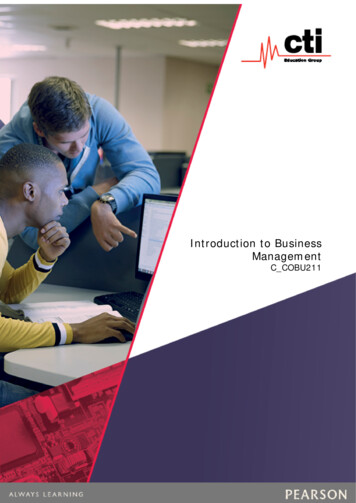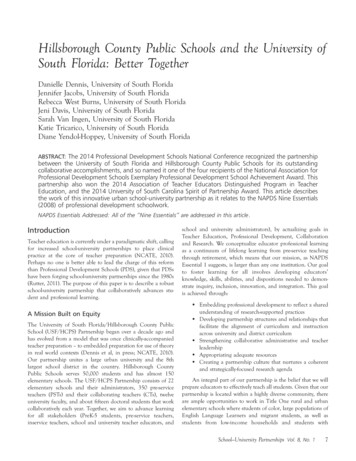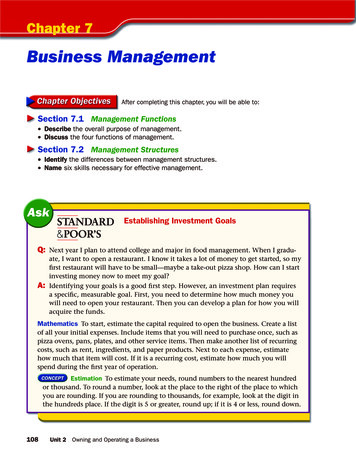
Transcription
Chapter 7Business ManagementAfter completing this chapter, you will be able to:Section 7.1 Management Functions Describe the overall purpose of management. Discuss the four functions of management.Section 7.2 Management Structures Identify the differences between management structures. Name six skills necessary for effective management.AskEstablishing Investment GoalsQ:Next year I plan to attend college and major in food management. When I graduate, I want to open a restaurant. I know it takes a lot of money to get started, so myfirst restaurant will have to be small—maybe a take-out pizza shop. How can I startinvesting money now to meet my goal?A:Identifying your goals is a good first step. However, an investment plan requiresa specific, measurable goal. First, you need to determine how much money youwill need to open your restaurant. Then you can develop a plan for how you willacquire the funds.Mathematics To start, estimate the capital required to open the business. Create a listof all your initial expenses. Include items that you will need to purchase once, such aspizza ovens, pans, plates, and other service items. Then make another list of recurringcosts, such as rent, ingredients, and paper products. Next to each expense, estimatehow much that item will cost. If it is a recurring cost, estimate how much you willspend during the first year of operation.Estimation To estimate your needs, round numbers to the nearest hundredor thousand. To round a number, look at the place to the right of the place to whichyou are rounding. If you are rounding to thousands, for example, look at the digit inthe hundreds place. If the digit is 5 or greater, round up; if it is 4 or less, round down.108Unit 2Owning and Operating a Business
Photo Credit: Artiga Photo/MasterfileCommunication Is Key Effective managershave good communication and people skills.Why do you think effective managers need tobe good communicators?Chapter 7Business Management109Photo Credit: vlkjdf;lkjeijeojf;ldkjl;dskfj;
Section 7.1Management FunctionsThink about the processes involved in managing a baseball teamand how they might apply in business.Read to Learn Describe the overall purpose ofmanagement. Discuss the four functions of management.The Main IdeaThe purpose of management is to set goalsfor the company and to help meet those goalsas efficiently and effectively as possible. Thereare four functions of management: planning,organizing, leading, and controlling.Academic VocabularyYou will find these words in your reading andon your tests. Make sure you know theirmeanings.focusteamsgoalsenforceGraphic OrganizerIn a figure like the one below, write examplesof the types of positions that might be heldby top-level managers, middle managers, andoperational managers.Key Concepts Introduction to Management The Four Functions of ManagerVocabularyKey Termsmanagementplanningorganizingorganizational charttop-level managermiddle manageroperational managerleadingcontrollingGo to the Introduction to Business OnlineLearning Center through glencoe.com fora printable graphic organizer.Academic StandardsEnglish Language ArtsNCTE 1 Read texts to acquire new informationMathematicsProblem Solving Apply and adapt a variety of appropriate strategies to solve problems; monitor andreflect on the process of mathematical problem solving110Chapter 7 Business Managementglencoe.com
Introduction to ManagementEntrepreneurs who start and run businesses by themselves donot have to manage other people. They have to manage themselves. However, if the firm has employees, then some type of management plan is necessary. Management includes the processes orfunctions of planning, organizing, leading, and controlling.For example, suppose you have created your own comic bookand want to start a comic book company. Do you want to produce comic books and market them as well? Do you also want toproduce cartoons, video games, and action figures based on yourcomic books? Because of the complexity of your business, youwill need employees to help. Managers can help by supervisingand directing employees.Management helps businesses focus on setting and meetinggoals efficiently and effectively so that a profit can be made. Theword management also refers to the people who are in charge ofrunning a business. Managers need a thorough understandingof business operations, which involve all the activities of a company. They develop the objectives for a firm or a department andthen figure out how to meet those objectives through people,work processes, and equipment.Think about allthe things that areinvolved in managingyour local grocerystore.The Four Functions ofManagementMost managers carry out four different functionsof management: planning, organizing, leading,and controlling. Some managers may primarilyfocus on one or two of them. These functions areindicated in the order in which they occur. Planning must be completed first, then organizationcan take place. Organization allows managers tolead and control employees and activities to getwork done. Leading involves providing guidance toemployees so they can fulfill their responsibilitieseffectively. Controlling involves measuring howthe business performs to ensure that financial andoperational goals are met.A challenge for many managers, especially insmall businesses, is dealing with multiple objectives,each at a different functional level. For example,suppose your company’s manager discusses plans toproduce a new comic book with the marketing andproduction teams. The manager directs the marketing team to research the national and global marketsfor comic books. The manager also tells the production team to prepare to produce the new product.A Conflict of InterestCritical Reading Life is full ofimportant decisions. Think about thekinds of decisions that you make asyou read the question below.You and your best friend, Jeremiah,were helping your little brother figureout how to make molded cars frommelted crayons using a kit you gavehim. You decide to sell the cars at alocal toy shop. Jeremiah hears youtalking with your business teacherabout your new business idea, andhe wants to be a partner.Decision Making Since Jeremiahwas involved in the initialexperiment, do you have anobligation to make him a partner inyour business venture? What aboutyour little brother? Should he alsoown a piece of the new business?What are the advantages anddisadvantages of a partnership?Explain your answer.Section 7.1 Management Functions111
It is up to the manager to organize, analyze, and monitor theproject to assure that the production process works efficientlyand effectively. Communicating with employees at all timeshelps assure that objectives are met. Figure 7.1 describes thefour functions of management.Describe What are the four functions ofmanagement?PlanningPlanning is the act or process of creating goals and objectivesas well as the strategies to meet them. Planning also involvesfiguring out the resources that are needed and the standards thatmust be met.Organizing and StaffingOrganizing is getting the resources arranged in an orderlyand functional way to accomplish goals and objectives. A manager must organize people, work processes, and equipment sothat the work is well coordinated. Managers also hire and trainemployees—and fire them when necessary. They are responsiblefor making sure employees have all the tools they need to dotheir jobs well.Figure 7.1Management FunctionsPLANNINGSetting objectives andmaking long- and shortterm plans for meeting theobjectivesORGANIZINGObtaining and coordinatingresources so that abusiness’s objectives canbe metLEADINGInfluencing, guiding, anddirecting people underone’s management to carryout their assigned tasksCONTROLLINGSetting standards for work,evaluating performance,and solving problems thatprevent certain tasks’completionManagement Functions Managers carry out four different functions.Which function involves coordinating resources?112Chapter 7 Business Management
Levels of Management Another important part of organizing isdetermining how different individuals in the firm relate to oneanother. An organizational chart shows how the firm is structured and who is in charge of whom.A top-level manager is responsible for setting goals and planning for the future as well as leading and controlling the work ofothers. There is only one top-level manager at the Small WondersComic Book Company because it is a small business. In largerfirms, top-level management can be composed of a chief executive officer (or CEO), a president, and at least one vice president.A middle manager carries out the decisions of top management. Middle managers are often responsible for various departments in a business, such as the production, marketing, andaccounting departments. Middle management is responsible forthe organizing function as well as leading and controlling thework of others. Although middle managers do some planning,they are usually responsible for carrying out plans made by topmanagement.An operational manager is responsible for the daily operations of a business. Supervisors, office managers, and crew leadersare types of operational managers. Operational managers also dosome planning and organizing. However, their main duties include overseeing workers and meeting deadlines(leading and controlling).Many companieshave eliminatedmiddle managers tosave money. Do youthink this is a goodbusiness practice?LeadingGood management also requiresgood leadership. There is more to leading than just giving orders. Leadingmeans providing direction and vision.You have to create a vision of the company to inspire your employees. Youneed to set standards, such as deadlinesand sales quotas, so your managers andworkers know their goals. Leaders alsohave to delegate work, enforce policies, oversee time management, andprovide feedback on employees’ work.Resolving conflicts between workers isalso a leadership task.Responsibilities of a ManagerA manager has many differentresponsibilities. What responsibilityis this manager fulfilling?Section 7.1 Management Functions113Photo Credit: Corbis RF
Real WorldIncentive PlansSome companiestry to motivateemployees withincentives such ason-site child care andbonuses. How do youthink offering suchbenefits can add to acompany’s costs?Good managers lead by example. This is especially importantwhen leading a team. Showing respect to others, honesty, loyalty,courtesy, and a strong work ethic can have a positive effect onemployees. Managers who show motivation, initiative, cooperation, and punctuality demonstrate to employees the importanceof each person’s contribution.Analyze Why is there more to leading than givingorders?ControllingControlling the operation means keeping the company ontrack and making sure goals are met. Managers keep track of thebudget, the schedule, and the quality of the products or servicesthey provide. They also monitor their employees and reviewtheir performance according to standards. Taking correctiveaction when goals are not met is another management task.Controlling also involves monitoring customer satisfaction.Your marketing manager can measure the success of your comicbook by studying sales figures and reviews. You might find outyour comic book sold well in certain parts of the country but soldpoorly in others. If your comic book is more popular with adultsthan children, you might want to develop a new marketing plan.Section 7.1Review Key Concepts1. What is management?2. What are three levels of management?3. Which of the three levels is most involved in the day-to-day supervision of employees?Academic Skills4. Mathematics You are a delivery manager at Blue Bag, a wholesale bakery.The bakery employs two drivers andowns two trucks. Each truck can deliverup to 175 crates of bread per day. Thebakery has standing orders for 340crates a day, but a new supermarketis opening up, and you expect ordersto increase 225%. If you hire two moredrivers, you can run two shifts. Will it beenough? Write a paragraph explaininghow you found your answer.Problem Solving: Reflect on theProblem-Solving Process Solving complexword problems such as this requiresthinking through different scenarios, writingequations to match those scenarios,solving those equations, and comparingthe results.For math help, go to theMath Appendix.Go to the Introduction to Business Online Learning Center throughglencoe.com to check your answers.114Chapter 7 Business Managementglencoe.com
Section 7.2Management StructuresThink about the characteristics you would need to be an effectivemanager.Read to Learn Identify the differences betweenmanagement structures. Name six skills necessary for effectivemanagement.The Main IdeaBusinesses have many different managementstructures that they can adopt. People who areinterested in management should pay attentionto the skills and knowledge needed to be aneffective manager.Academic VocabularyYou will find these words in your reading andon your tests. Make sure you know ic OrganizerIn a figure like the one below, list the qualitiesyou need to be a good manager as you read.Key Concepts Managerial Structures Is a Manager’s Job for You?Skills Needed byManagersVocabularyKey Termsline authorityline and staff authoritycentralized organizationdecentralized organizationdepartmentalizationentry-level jobGo to the Introduction to Business OnlineLearning Center through glencoe.com fora printable graphic organizer.Academic StandardsEnglish Language ArtsNCTE 1 Read texts to acquire new informationNCTE 4 Use written language to communicate effectivelyNCTE 9 Develop an understanding of diversity in language use across culturesNCTE 12 Use language to accomplish individual purposesScienceContent Standard A Students should develop abilities necessary to do scientific inquiry andunderstandings about scientific inquiryglencoe.comSection 7.2Management Structures115
Managerial StructuresThere are several ways to organize a management structure.Line authority is an organizational structure in which managerson one level are in charge of those beneath them. An advantageof the line authority structure is that authority is clearly defined.Each employee knows to whom she or he reports. A disadvantageto line authority is that the managers have few specialists whohelp with their responsibilities.A line and staff authority organizational chart shows thedirect line of authority (indicated by solid lines) as well asstaff who advise the line personnel (indicated by dotted lines).Figure 7.2 shows a line and staff organizational chart. The lineand staff authority structure enables managers to get advice.However, a disadvantage is that it can lead to overstaffing,which can be costly.Some firms have a centralized organization that puts authority in one place—with top management. This helps managersthroughout the firm to be consistent in decision making.Figure 7.2Line and Staff Authority Organization Chart&OUSFQSFOFVS .BOBHFS1FSTPOOFM .BOBHFS#PPLLFFQFS"TTJTUBOU .BOBHFS8BSFIPVTF .BOBHFS1VSDIBTJOH .BOBHFS#VZFS#VZFS8BSFIPVTF &NQMPZFF8BSFIPVTF &NQMPZFF4BMFT .BOBHFS4BMFT 3FQSolid and Dotted Lines A line and staff organizational chart shows different roles ofstaff with different types of lines. What is the difference between the personnel linkedby solid lines and staff positions linked by dotted lines?116Chapter 7 Business Management4BMFT 3FQ
Decentralized organization gives authority to a numberof different managers. Decentralized organizations are oftenevident in international businesses. Some U.S. managers working in foreign countries have more decision-making powerbecause they know their markets well.Contrast What is the advantage and thedisadvantage of line authority?Formal StructureFormal structures are usually departmentalized.Departmentalization divides responsibility among specificunits, or departments. Departments can be organized many different ways, such as by geographical location, function, customergroups, and product.Informal StructureSmaller businesses can be run informally. If a business doesnot need a big marketing or distribution network, it does notneed a lot of managers. Employees can be more flexible andshare duties. For example, partners can work on projects aloneor together. The informal structure often works well for them.Real WorldEmployee InputForward-lookingcompanies areon a new track toencourage workerparticipation, newways of thinking, anda move away froma formal structure.How is this good forbusiness?Think about aninformal businessyou have seen orread about. Do youthink this type ofbusiness can besuccessful?Decision ScienceSolving highly complex business problems requires a managerto be an effective decision maker. Effective decision makers seekinput from many sources and gather varied data to inform theirthinking about business problems. Since the 1940s, the field ofdecision science, also known as management science or successscience, has developed new ways to use mathematics and thescientific method to make decisions. Business managers facedwith the need to analyze mounds of data and choose among riskyalternatives can hire decision scientists to help them. These consultants offer data analysis services, education in mathematicalconcepts, and data analysis tools and techniques.Decision science evolved from game theory, which deals largelywith how individuals interact with one another in an effort to win.Go to the Introduction to Business Online Learning Center throughglencoe.com for links to Web sites where you can research moreabout how game theory and decision science have developed sincethe 1940s. Write a paragraph or two describing how an understanding of game theory and decision science could help a personmake complex business decisions.glencoe.comSection 7.2 Management Structures117
Is a Manager’s Job for You?Most managers begin their career in an entry-level job. Anentry-level job is a beginner-level position. New employees whogain experience and show certain qualities can be promoted tohigher positions, including management.Skills Needed by ManagersManagers are usually task-oriented. This means that they canhandle many tasks at the same time. They have to plan theirtime and decide which tasks are most important. They also mustkeep accurate business records. A manager often has to workunder pressure and solve many small problems. Good problemsolving and time-management skills are a must. Every managermust communicate well. Most of a manager’s day is spent interacting with other people. This involves listening, an importantpart of communication. Managers need human relations skills,or skills in dealing with people. All managers must have someknowledge about the technical aspects of their business.Reader and Case StudyA Board of Your OwnWhere can small companies turn for objectiveadvice? To each other, thanks to peer groupssuch as The Alternative Board.When Daryl Rossman, president of MercoManufacturing, wanted feedback about expanding his family-owned aerospace parts manufacturer or needed advice on strategy andmarketing, his options were limited. He couldgo to the expense of hiring an outside accountant, lawyer, or business consultant. Or he coulddiscuss his views internally with one of his 16employees.“Being a small business, I didn’t really haveanybody to sound off my ideas with other thanmy own employees,” he says. “But I alwaysfelt they were biased. They would say what Iwanted to hear and give me the response I waslooking for.”However, since last March, Rossman hassought the objective advice of The AlternativeBoard (TAB), a peer advisory group that bringstogether small- and midsize-business owners118Chapter 7 Business Managementfrom noncompeting companies to share theircollective wisdom and act as a professionalsounding board. A kind of small-business thinktank that meets on a monthly basis, TAB
Learning Center through glencoe.com for a printable graphic organizer. Think about the processes involved in managing a baseball team and how they might apply in business. Top-Level Manager Middle Manager Operatio

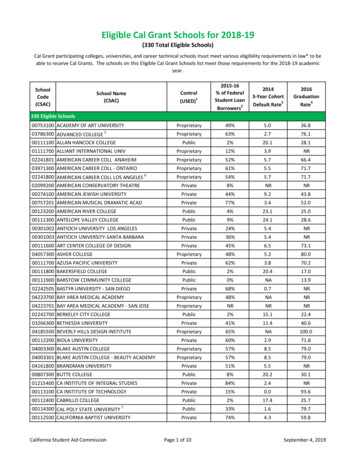
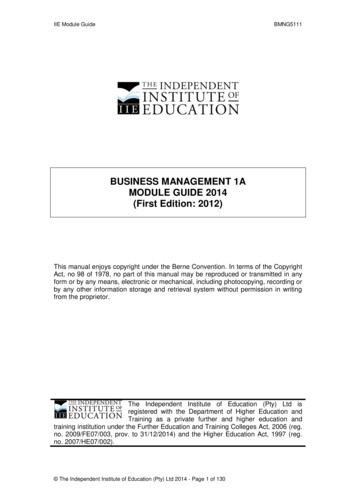
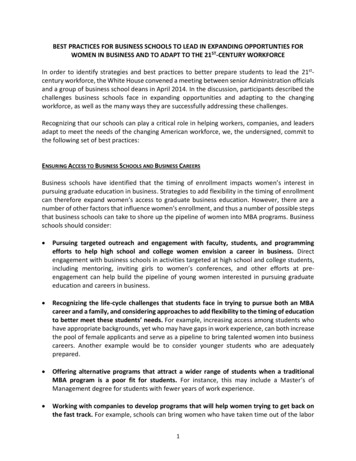

![GLOBAL MASTER IN BUSINESS ADMINISTRATION [GMBA]](/img/9/cat-p-192-i.jpg)
